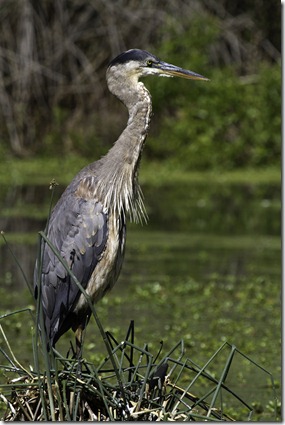Phil’s Photo Monday
Great Blue Heron by: Phil Robertson
Cool Facts
Thanks to specially shaped neck vertebrae, Great Blue Herons can curl their neck into an S shape for a more aerodynamic flight profile and to quickly strike prey at a distance.
Great Blue Herons have specialized feathers on their chest that continually grow and fray. The herons comb this “powder down” with a fringed claw on their middle toes, using the down like a washcloth to remove fish slime and other oils from their feathers as they preen. Applying the powder to their under parts protects their feathers against the slime and oils of swamps.
Great Blue Herons can hunt day and night thanks to a high percentage of rod-type photoreceptors in their eyes that improve their night vision.
Despite their impressive size, Great Blue Herons weigh only 5 to 6 pounds thanks in part to their hollow bones—a feature all birds share.
Great Blue Herons in the northeastern U.S. and southern Canada have benefited from the recovery of beaver populations, which have created a patchwork of swamps and meadows well-suited to foraging and nesting.
Along the Pacific coast, it’s not unusual to see a Great Blue Heron poised atop a floating bed of kelp waiting for a meal to swim by.
The white form of the Great Blue Heron, known as the “great white heron,” is found nearly exclusively in shallow marine waters along the coast of very southern Florida, the Yucatan Peninsula, and in the Caribbean. Where the dark and white forms overlap in Florida, intermediate birds known as “Wurdemann’s herons” can be found. They have the body of a Great Blue Heron, but the white head and neck of the great white heron.
The oldest Great Blue Heron, based on banding recovery, was 24 years old.
Great Blue Herons congregate at fish hatcheries, creating potential problems for the fish farmers. A study found that herons ate mostly diseased fish that would have died shortly anyway. Sick fish spent more time near the surface of the water where they were more vulnerable to the herons.
Habitat
Marsh
Great Blue Herons live in both freshwater and saltwater habitats, and also forage in grasslands and agricultural fields, where they stalk frogs and mammals. Most breeding colonies are located within 2 to 4 miles of feeding areas, often in isolated swamps or on islands, and near lakes and ponds bordered by forests.
Food
Fish
Great Blue Herons eat nearly anything within striking distance, including fish, amphibians, reptiles, small mammals, insects, and other birds. They grab smaller prey in their strong mandibles or use their dagger-like bills to impale larger fish, often shaking them to break or relax the sharp spines before gulping them down.
Nesting
Nesting Facts
Clutch Size
2–6 eggs
Number of Broods
1-2 broods
Egg Length
2.4–3 in
Egg Width
1.8–2 in
Incubation Period
27–29 days
Nestling Period
49–81 days
Egg Description
Pale blue, fading slightly with age.
Condition at Hatching
Bluish eyes open, chick covered in pale gray down, able to vocalize.
Nest Description
Male Great Blue Herons collect much of the nest material, gathering sticks from the ground and nearby shrubs and trees, and from unguarded and abandoned nests, and presenting them to the female. She weaves a platform and a saucer-shaped nest cup, lining it with pine needles, moss, reeds, dry grass, mangrove leaves, or small twigs. Nest building can take from 3 days up to 2 weeks; the finished nest can range from a simple platform measuring 20 inches across to more elaborate structures used over multiple years, reaching 4 feet across and nearly 3.5 feet deep. Ground-nesting herons use vegetation such as salt grass to form the nest.
Nest Placement
Tree
Great Blue Herons nest mainly in trees, but will also nest on the ground, on bushes, in mangroves, and on structures such as duck blinds, channel markers, or artificial nest platforms. Males arrive at the colony and settle on nest sites; from there, they court passing females. Colonies can consist of 500 or more individual nests, with multiple nests per tree built 100 or more feet off the ground.
Behavior
Stalking
Great Blue Herons forage, usually alone, across much of the U.S. This largest of the North American herons wades slowly or stands stock still, peering into the water for prey. In flight the Great Blue Heron folds it neck into an “S” shape and trails its long legs behind, dangling them as it prepares to land or when courting. Breeding birds nest in colonies that can number several hundred pairs, where they build stick nests in trees, on bushes, or on the ground. If you visit a colony, look for elaborate courtship and pair-bonding displays that include a ritualized greeting, stick transfers, and nest relief ceremony in which the birds erect their plumes and “clapper” their bill tips. Pairs are mostly monogamous during a season, but they choose new partners each year. Away from the colony, Great Blue Herons defend feeding territories from other herons with dramatic displays in which the birds approach intruders with their head thrown back, wings outstretched, and bill pointing skyward. Gulls and even humans may also be a target of this defensive maneuver.
Conservation
status via IUCN
Least Concern
Great Blue Heron numbers are generally stable and in some places increasing across the U.S. Some local population declines have occurred, particularly in the “great white heron” group in southern Florida, where elevated mercury levels in local waterways may be a factor. Because they depend on wetlands for feeding and on relatively undisturbed sites for breeding, Great Blue Herons are vulnerable to habitat loss and to impacts such as traffic, logging, motorboats, and other human intrusions that can disrupt nesting colonies. Other threats include chemical pollutants or other causes of reduced water quality. Although contaminant levels have declined in many areas, pollutants such as PCBs and DDT and newer types of industrial chemicals continue to affect heron habitats and can contribute to factors such as reduced nest site attendance.
Source: http://www.allaboutbirds.org/guide/Great_Blue_Heron/lifehistory

 (916) 434-2759
(916) 434-2759



